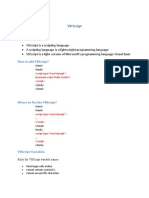0 ratings0% found this document useful (0 votes)
105 viewsML Programming Languages
ML is a functional programming language developed in the 1970s at the University of Edinburgh. It is strongly typed, with type checking done during compilation. Key features include union types, parametric polymorphism, recursion, exceptions, and lists. Functions are defined using the fun keyword and patterns can be matched using pipes. Common operations include arithmetic, conditionals, concatenation, and basic data types like int, bool, real, char, and strings.
Uploaded by
soundarpandiyanCopyright
© Attribution Non-Commercial (BY-NC)
Available Formats
Download as DOC, PDF, TXT or read online on Scribd
0 ratings0% found this document useful (0 votes)
105 viewsML Programming Languages
ML is a functional programming language developed in the 1970s at the University of Edinburgh. It is strongly typed, with type checking done during compilation. Key features include union types, parametric polymorphism, recursion, exceptions, and lists. Functions are defined using the fun keyword and patterns can be matched using pipes. Common operations include arithmetic, conditionals, concatenation, and basic data types like int, bool, real, char, and strings.
Uploaded by
soundarpandiyanCopyright
© Attribution Non-Commercial (BY-NC)
Available Formats
Download as DOC, PDF, TXT or read online on Scribd
You are on page 1/ 2
• Primarily a functional programming language.
• ML is a strongly typed language, need not declare data type
• Developed in late 1970 as part of system for providing correctness of programs
• Developed at university of Edinburgh in UK
• By a team headed by Robin Milner and Michael Gordon
• Influenced the creation of Miranda, Haskell, Cyclone, Nemerle, C++, Clojure
Important features are
• Union
• Conflict
• Recursive
• Parametric module
• Exceptional handling mechanism
• Polymorphism data types and function
• In ML there are two phases of program execution consisting of static phase for approval of program
correctness & dynamic phase that is program execution.
• No use of parenthesis
• The syntax is strongly typed, allowing type of every expression to determined before execution and
types to be checked for consistency
Principles of ML
• ML expressions must be followed by a semicolon
• ML responds for any definition through the following primitives
o val stands for value
o it the variable ‘it’ stands for definition value
o : represent the association of value with a type
Operator:
• Arithmetic: +-*/, mod for remainder of integer
• / is for division of real numbers and div for division of integers
• string concatenation ^
• Conditional operator = ,>,<,>=,<=,<>
• ‘and also’ for logical and & ‘or else’ for logical or
Primitive Data types
int, boolean, real, character and string
Structured data types or derived
List and Tuple
Tuple is a group of n values
List is formed by taking variables of same datatype.
Functions
Syntax : fun function_name (Parameter list) = function body;
Eg; fun number(x : int)= x+5;
Factorial function:
fun fact n = let
fun fac 0 = 1
| fac n = n * fac (n - 1)
in
if (n < 0) then raise Fail "negative argument"
else fac n
end
List reverse function:
The following function not only reverses the list but also returns the reversed list.
fun reverse xs = let
fun rev nil acc = acc
| rev (hd::tl) acc = rev tl (hd::acc)
in
rev xs nil
end
You might also like
- CMSC 22100/32100: Programming Languages An Overview of Standard ML M. Blume October 2, 2008No ratings yetCMSC 22100/32100: Programming Languages An Overview of Standard ML M. Blume October 2, 200824 pages
- Begin at The Beginning : Exec-Time "Dynamic"No ratings yetBegin at The Beginning : Exec-Time "Dynamic"60 pages
- Chapter 9: Functional Programming in A Typed LanguageNo ratings yetChapter 9: Functional Programming in A Typed Language40 pages
- Standard ML Mini-Tutorial (In Particular SML/NJ) : Programming Languages CS442No ratings yetStandard ML Mini-Tutorial (In Particular SML/NJ) : Programming Languages CS44221 pages
- Study Notes On Graham Hutton's Haskell Book (2nd Edition)No ratings yetStudy Notes On Graham Hutton's Haskell Book (2nd Edition)24 pages
- CSE341: Programming Languages Spring 2019 Unit 1 Summary Dan Grossman, University of WashingtonNo ratings yetCSE341: Programming Languages Spring 2019 Unit 1 Summary Dan Grossman, University of Washington13 pages
- CT006!3!3 ADPLC 02 FunctionalProgramming Part 1No ratings yetCT006!3!3 ADPLC 02 FunctionalProgramming Part 142 pages
- Computational Linguistics With The Zen Attitude: Department of Sanskrit StudiesNo ratings yetComputational Linguistics With The Zen Attitude: Department of Sanskrit Studies27 pages
- Coursera Programming Languages Course Section 1 SummaryNo ratings yetCoursera Programming Languages Course Section 1 Summary14 pages
- Reverse of A List: A Simple Case Study in Lisp Programming: Tudor Jebelean, Mar 2009No ratings yetReverse of A List: A Simple Case Study in Lisp Programming: Tudor Jebelean, Mar 20098 pages
- Lecture Week 11 - ML and Hierarchical PNsNo ratings yetLecture Week 11 - ML and Hierarchical PNs31 pages
- Parameters: Chapter Eighteen Modern Programming Languages 1No ratings yetParameters: Chapter Eighteen Modern Programming Languages 149 pages
- ASCII Chart Decimal Octal Hex Character Description: S. Balaraman100% (1)ASCII Chart Decimal Octal Hex Character Description: S. Balaraman3 pages









































































